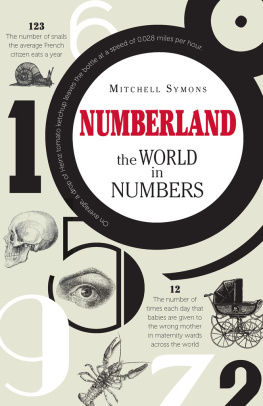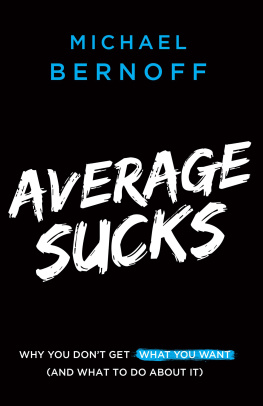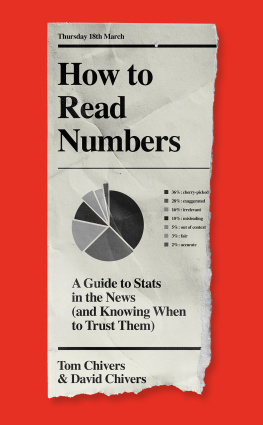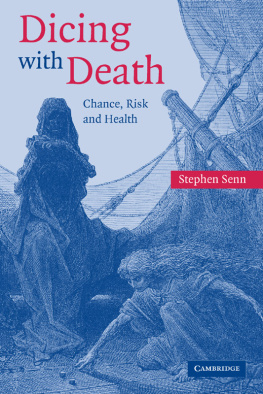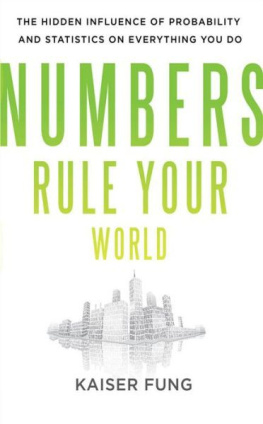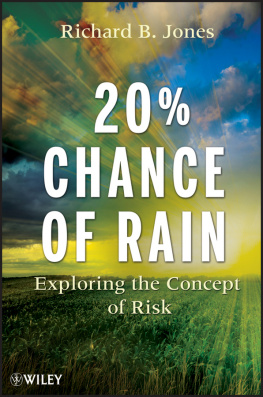THE NORM CHRONICLES
Despite starting out telling stories as an English Literature graduate working in journalism, MICHAEL BLASTLAND somehow learned to count, devising the Radio 4 programme about numbers More or Less and writing, with Andrew Dilnot, The Tiger That Isnt, a guide to numbers in the news. On ice skates, he is life-threatening (mostly its his own life) but more afraid of other peoples raised umbrellas. His other risk dislikes include confined spaces, heights and fairground rides.
DAVID SPIEGELHALTER is a statistician who rejoices in the title of Winton Professor for the Public Understanding of Risk at Cambridge University. He is, or was, a proper academic and has far too many letters after his name, but feels his greatest achievement is not doing badly in the risky TV programme Winter Wipeout. He lives in a flood zone, but is more anxious about forgetting where he put the house keys. He particularly likes heights, confined spaces and fairground rides.
Together, Blastland and Spiegelhalter sound like a Dickensian music-hall act or a firm of dodgy solicitors. But they think that combining ideas and perspectives is the best way to make sense of the subjects of this book: danger, risk and chance subjects that could be said to exist, as they hope to show, only in a clash of viewpoints.
For Ron and Shirley MB
For Kate, Kate and Rosie, for putting up with me DS
THE NORM CHRONICLES
Stories and Numbers about Danger
MICHAEL BLASTLAND
and
DAVID SPIEGELHALTER

First published in Great Britain in 2013 by
PROFILE BOOKS LTD
3A Exmouth House
Pine Street
London EC1R 0JH
www.profilebooks.com
Copyright Michael Blastland and David Spiegelhalter, 2013
1 3 5 7 9 10 8 6 4 2
Typeset in Garamond by MacGuru Ltd
info@macguru.org.uk
Printed and bound in Great Britain by
Clays, Bungay, Suffolk
The moral right of the authors has been asserted.
All rights reserved. Without limiting the rights under copyright reserved above, no part of this publication may be reproduced, stored or introduced into a retrieval system, or transmitted, in any form or by any means (electronic, mechanical, photocopying, recording or otherwise), without the prior written permission of both the copyright owner and the publisher of this book.
A CIP catalogue record for this book is available from the British Library.
ISBN 978 1 84668 620 7
eISBN 978 1 84765 829 6
The paper this book is printed on is certified by the 1996 Forest Stewardship Council A.C. (FSC). It is ancient-forest friendly. The printer holds FSC chain of custody SGS-COC-2061

CONTENTS
INTRODUCTION
A SHORT STORY about danger:
One day, by devilish coincidence, three people travelling separately on the tube Norm, Prudence and Kelvin saw three unattended bags.
For Norm it was a dusty-blue canvas hold-all on the floor, tucked against the seat on his side. At first, he thought nothing of it. Then he looked again, and then up and down the carriage. Almost empty.
Calm, Norm, he said to himself, and reached down to pull up his socks the green thermal ones glancing sideways for wires. He sat up and forced himself to focus on the probabilities, scratched his nose, concluded several times that the bag had been forgotten, thats all, stood up and went slowly to the far doors to get off at the next stop and enjoy the extra walk.
When Prudence looked up from Fifty Shades of Grey to see a pristine rucksack on the seat opposite, she felt quickly sick. If it has a travel tag, someone is taking it somewhere. If it doesnt
It didnt. She thought of her children, motherless, crying, and lost the strength to move. Her mind filled with hellish images of herself blown apart and her hair ruined.
Counting out the last seconds of her life, ticking to the blast, she gestured and mouthed at a passenger standing nearby, a warning, a hope: a bag, she mumbled, and pointed like the ghost she was becoming.
Oh, yeah, he said, and grabbed it. Cheers.
And Kelvin? When he clocked a black briefcase as the doors slid open, he opened it what else? Picked it up, sat down, flipped up the suckers lid, took out a folded Daily Telegraph and slid it into the side-pocket of his leather jacket, shuftied a wad of paperwork, noticed a foil wrap down the side, teased it open, lifted it to his nose, snorted with an eye on the teenage girl further down, doing her lashes threw in the wrapper, closed the lid, put down the bag, sat back and closed his eyes.
Three people, three points of view about danger, to which we could add many more. Whats yours? Danger, as every experience and a million stories tell us, is in the nerves of the beholder.
But not entirely. There are also numbers.
Here are two. The first is terrible and well known: on 7 July 2005, 52 people died in terrorist bomb attacks on underground trains and a bus in central London. Second, in 2011 about 30,000 bags were left on London Transport. Let that sink in: 30,000.
So, is an unattended bag on the tube dangerous? How do the numbers and stories compare: the particular stories of the 52, and those of Norm, Kelvin and Prudence?
Leave that question burning for a moment, for another short story, a true and famous one.
One day Anna and her friends went skiing. Anna was a good skier, and in any case theres not much chance that skiing will kill you. Then she lost control. She fell onto her back on a frozen stream near a waterfall. A hole opened in the ice. Freezing water poured into her clothes and pulled her in, head first.
She would have been dead in minutes, but under the ice she found an air pocket. She could breathe, for a while. First her friends, then a rescue team, tried to pull her out. They failed. They tried to dig her out. The ice was too hard.
Anna remained conscious for 40 minutes. But finally her breathing slowed, and then stopped. Then so did her pulse. It was another 40 minutes before she was pulled clear.
Normal body temperature is 37Celsius. Hypothermia begins to set in at about 35C. When Anna arrived at hospital, her temperature was 13.7C. No one that cold had ever lived.
But the doctors did not give up. Slowly, patiently, they warmed her blood outside her body, then pumped it back into her veins. More than three hours after she stopped breathing, more than two hours after she arrived at hospital, Annas heart began to beat again.
But when she woke, ten days later, it was to find herself paralysed from the neck down, and one of her first feelings was anger that she had been revived, for this. Then she made an almost full recovery. A few years later she was working as a radiologist at the hospital that saved her life. She still goes skiing.
Annas story is now celebrated as a marvel of survival and a medical revelation. But for us it makes a different point that has little to do with human endurance or scientific understanding of the effects of extreme cold, and is simply this: Anna rode the mother of all fortunes roller-coasters. At every turn in a twisting tale, at every roll of the dice for good or bad, it was as if she threw six 6s. All her luck was extreme.
Anyone can fall, even those who ski well. But how and where Anna fell into that concurrence of water, hole and hard ice was absurdly unlikely. Then to find an air pocket was a godsend, or seemed so, but for the maddening, desperate twist that made it so hard to pull her out. To be visibly dead from such extreme cold and yet live was impossible, until she did it; then to survive but in the end wake up paralysed, except that the end was still to come with almost full recovery, was one amazement after another. And behind every turn was the most twisted of all: that it was near-death that saved her, when fatally bitter cold turned out by slowing her metabolism down nearly to a stand-still at just the right moment to preserve a kernel of life precisely when breath stopped. Life is sometimes improbable.
Next page




